A Buckling Analysis of Thermoelastic Micro/Nano-Beams Considering the Size-Dependent Effect and Non-Uniform Temperature Distribution
Abstract
:1. Introduction
2. Formulation of the Problem
2.1. Mechanical Governing Equation
2.2. Temperature Field Governing Equation
3. Buckling Analysis
- Clamped–clamped micro/nano-beams (CC), i.e.,
- Simply supported micro/nano-beams (SS), i.e.,
- Simply supported–clamped micro/nano-beams (CS), i.e.,
4. Numerical Results and Discussion
4.1. Influence of Mechanical Small Scale Effect on Critical Load
4.2. Influence of Thermal Small Scale Effect on Critical Load
4.3. Influence of Combined Mechanical and Thermal Small Scale Effects on Critical Load
4.4. Influence of Other Key Factors on Critical Load
5. Conclusions Remarks
- A critical thickness is proposed: as the beam thickness is less than the critical thickness, the influence of both mechanical and thermal small scale effects on the buckling load must be considered. As beam thickness is larger than the critical thickness, the influence of both mechanical and thermal small scale effects on the buckling load can be neglected, and the classical buckling model can be applied for theoretical prediction of the buckling load. In short, the critical thickness can be used to distinguish the influence region of the small scale effect in practical engineering applications.
- The critical load depends on the boundary conditions, the length-to-thickness ratio and Poisson’s ratio. These findings are useful to the design of micro/nano-beams.
- In the influence region of the small scale effect, the combined small scale effects can give rise to a larger critical load. Specifically, the surface effect leads to a “hard beam”, mechanical non-local effect leads to a “soft beam” and thermal non-local effect leads to a larger critical load. The surface effect has great influence on the critical load compared to both mechanical and thermal small scale effects.
Author Contributions
Funding
Institutional Review Board Statement
Informed Consent Statement
Data Availability Statement
Conflicts of Interest
References
- Qian, C.J.; Villafañe, V.; Petrić, M.M.; Soubelet, P.; Stier, A.V.; Finley, J.J. Coupling of MoS2 excitons with lattice phonons and cavity vibrational phonons in hybrid nanobeam cavities. Phys. Rev. Lett. 2023, 130, 126901. [Google Scholar] [CrossRef]
- Awrejcewicz, J.; Krysko, A.V.; Smirnov, A.; Kalutsky, L.A.; Zhigalov, M.V.; Krysko, V.A. Mathematical modeling and methods of analysis of generalized functionally gradient porous nanobeams and nanoplates subjected to temperature field. Meccanica 2022, 57, 1591–1616. [Google Scholar] [CrossRef]
- Krysko, A.V.; Krysko, V.A.; Papkova, I.V.; Yakovleva, T.V. General theory of porous functionally gradient MEMS/NEMS beam resonators subjected to temperature field. In Proceedings of the 29th Saint Petersburg International Conference on Integrated Navigation Systems (ICINS), Saint Petersburg, Russia, 30 May–1 June 2022. [Google Scholar]
- Chapuis, O.; Greffet, J.; Joulain, K.; Volz, S. Heat transfer between a nano-tip and a surface. Nanotechnology 2006, 17, 2978–2981. [Google Scholar] [CrossRef]
- Schiwietz, D.; Weig, E.M.; Degenfeld-Schonburg, P. Thermoelastic damping in MEMS gyroscopes at high frequencies. Microsyst. Nanoeng. 2023, 9, 11. [Google Scholar] [CrossRef] [PubMed]
- Babaei, H. Thermoelastic buckling and post-buckling behavior of temperature-dependent nanocomposite pipes reinforced with CNTs. Eur. Phys. J. Plus 2021, 136, 1093. [Google Scholar] [CrossRef]
- Avey, M.; Sofiyev, A.H.; Kuruoglu, N. Influences of elastic foundations and thermal environments on the thermoelastic buckling of nanocomposite truncated conical shells. Acta Mech. 2022, 233, 685–700. [Google Scholar] [CrossRef]
- Le, T.N.T.; Hoang, V.T. Thermoelastic stability of thin CNT-reinforced composite cylindrical panels with elastically restrained edges under nonuniform in-plane temperature distribution. J. Thermoplast. Compos. Mater. 2023, 36, 768–793. [Google Scholar]
- Rahmani, O.; Hosseini, S.; Ghoytasi, I.; Golmohammadi, H. Buckling and free vibration of shallow curved micro/nano-beam based on strain gradient theory under thermal loading with temperature-dependent properties. Appl. Phys. A Mater. Sci. Process. 2017, 123, 4. [Google Scholar] [CrossRef]
- Nesarhosseini, S.; Ansari, R.; Faraji, O.M.; Rouhi, H. Thermally induced vibration analysis of Timoshenko beams based on the micropolar thermoelasticity. Acta Mech. 2023, 234, 1957–1971. [Google Scholar] [CrossRef]
- Kumar, R. Effect of phase-lag on thermoelastic vibration of Timoshenko beam. J. Therm. Stress. 2020, 43, 1337–1354. [Google Scholar] [CrossRef]
- Sahmani, S.; Ansari, R. Size-dependent buckling analysis of functionally graded third-order shear deformable microbeams including thermal environment effect. Appl. Math. Model. 2013, 37, 9499–9515. [Google Scholar] [CrossRef]
- Ke, L.L.; Wang, Y.S.; Wang, Z.D. Thermal effect on free vibration and buckling of size-dependent microbeams. Phys. E Low-Dimens. Syst. Nanostructures 2011, 43, 1387–1393. [Google Scholar] [CrossRef]
- Wang, Y.; Wang, Z.Q.; Lv, J.G. Size-dependent thermal buckling of heated nanowires with ends axially restrained. Phys. Lett. A 2014, 378, 899–903. [Google Scholar] [CrossRef]
- Shi, S.; He, T.; Jin, F. Thermoelastic damping analysis of size-dependent nano-resonators considering dual-phase-lag heat conduction model and surface effect. Int. J. Heat Mass Transf. 2021, 170, 120977. [Google Scholar] [CrossRef]
- Ren, Y.; Huo, R.; Zhou, D. Thermo-mechanical buckling analysis of non-uniformly heated rectangular plates with temperature-dependent material properties. Thin-Walled Struct. 2023, 186, 110653. [Google Scholar] [CrossRef]
- Lee, H.L.; Chu, S.S.; Chang, W.J. Vibration analysis of scanning thermal microscope probe nanomachining using Timoshenko beam theory. Curr. Appl. Phys. 2010, 10, 570–573. [Google Scholar] [CrossRef]
- Ebrahimi, F.; Salari, E. Thermal buckling and free vibration analysis of size dependent Timoshenko FG nanobeams in thermal environments. Compos. Struct. 2015, 128, 363–380. [Google Scholar] [CrossRef]
- Yu, Y.J.; Xue, Z.N.; Li, C.L.; Tian, X.G. Buckling of nanobeams under nonuniform temperature based on nonlocal thermoelasticity. Compos. Struct. 2016, 146, 108–113. [Google Scholar] [CrossRef]
- Yu, Y.; Tian, X.; Xiong, Q. Size-dependent thermoelasticity based on nonlocal heat conduction and nonlocal elasticity. Eur. J. Mech. A Solids 2016, 60, 238–253. [Google Scholar] [CrossRef]
- Zhang, P.; Qing, H. A bi-Helmholtz type of two-phase nonlocal integral model for buckling of Bernoulli-Euler beams under non-uniform temperature. J. Therm. Stress. 2021, 44, 1053–1067. [Google Scholar] [CrossRef]
- Xu, C.; Li, Y.; Lu, M.; Dai, Z. Buckling analysis of functionally graded nanobeams under non-uniform temperature using stress-driven nonlocal elasticity. Appl. Math. Mech. 2022, 43, 355–370. [Google Scholar] [CrossRef]
- Chang, C.W.; Okawa, D.; Garcia, H.; Majumdar, A.; Zettl, A. Breakdown of Fourier’s law in nanotube thermal conductors. Phys. Rev. Lett. 2008, 101, 075903. [Google Scholar] [CrossRef] [PubMed]
- Tzou, D.Y.; Guo, Z.Y. Nonlocal behavior in thermal lagging. Int. J. Therm. Sci. 2010, 49, 1133–1137. [Google Scholar] [CrossRef]
- Tzou, D.Y. Macro-to Microscale Heat Transfer: The Lagging Behavior, 2nd ed.; John Wiley & Sons: Chichester, UK, 2015. [Google Scholar]
- Eringen, A.C. Non-Local Continuum Field Theories; Springer: New York, NY, USA, 2002. [Google Scholar]
- Gurtin, M.E.; Murdoch, A.I. A continuum theory of elastic material surfaces. Arch. Ration. Mech. Anal. 1975, 57, 291–323. [Google Scholar] [CrossRef]
- Lee, H.L.; Chang, W.J. Surface effects on axial buckling of nonuniform nanowires using non-local elasticity theory. Micro Nano Lett. 2011, 6, 19–21. [Google Scholar] [CrossRef]
- Parviz, M.; Mohamad, S. Surface and nonlocal effects on the nonlinear free vibration of non-uniform nanobeams. Compos. Part B 2013, 52, 84–92. [Google Scholar]
- He, J.; Lilley, C.M. Surface effect on the elastic behavior of static bending nanowires. Nano Lett. 2008, 8, 1798–1802. [Google Scholar] [CrossRef]
- Kumar, D.; Heinrich, C.; Waas, A.M. Buckling analysis of carbon nanotubes modeled using nonlocal continuum theories. J. Appl. Phys. 2008, 103, 073521. [Google Scholar] [CrossRef]
- Li, C.; Yao, L.; Chen, W.; Li, S. Comments on nonlocal effects in nano-cantilever beams. Int. J. Eng. Sci. 2015, 87, 47–57. [Google Scholar] [CrossRef]
- Timoshenko, S.P.; Gere, J.M. Theory of Elastic Stability; McGraw-Hill: New York, NY, USA, 1961. [Google Scholar]
- Sun, Y.; Fang, D.; Saka, M.; Soh, A.K. Laser-induced vibrations of micro-beams under different boundary conditions. Int. J. Solids Struct. 2008, 45, 1993–2013. [Google Scholar] [CrossRef]
- Shi, S.; Jin, F.; He, T.; Shi, G. Thermoelastic damping analysis model of transversely isotropic micro/ nano-resonators based on dual-phase-lag heat conduction model and surface effect. Compos. Struct. 2022, 292, 119664. [Google Scholar] [CrossRef]
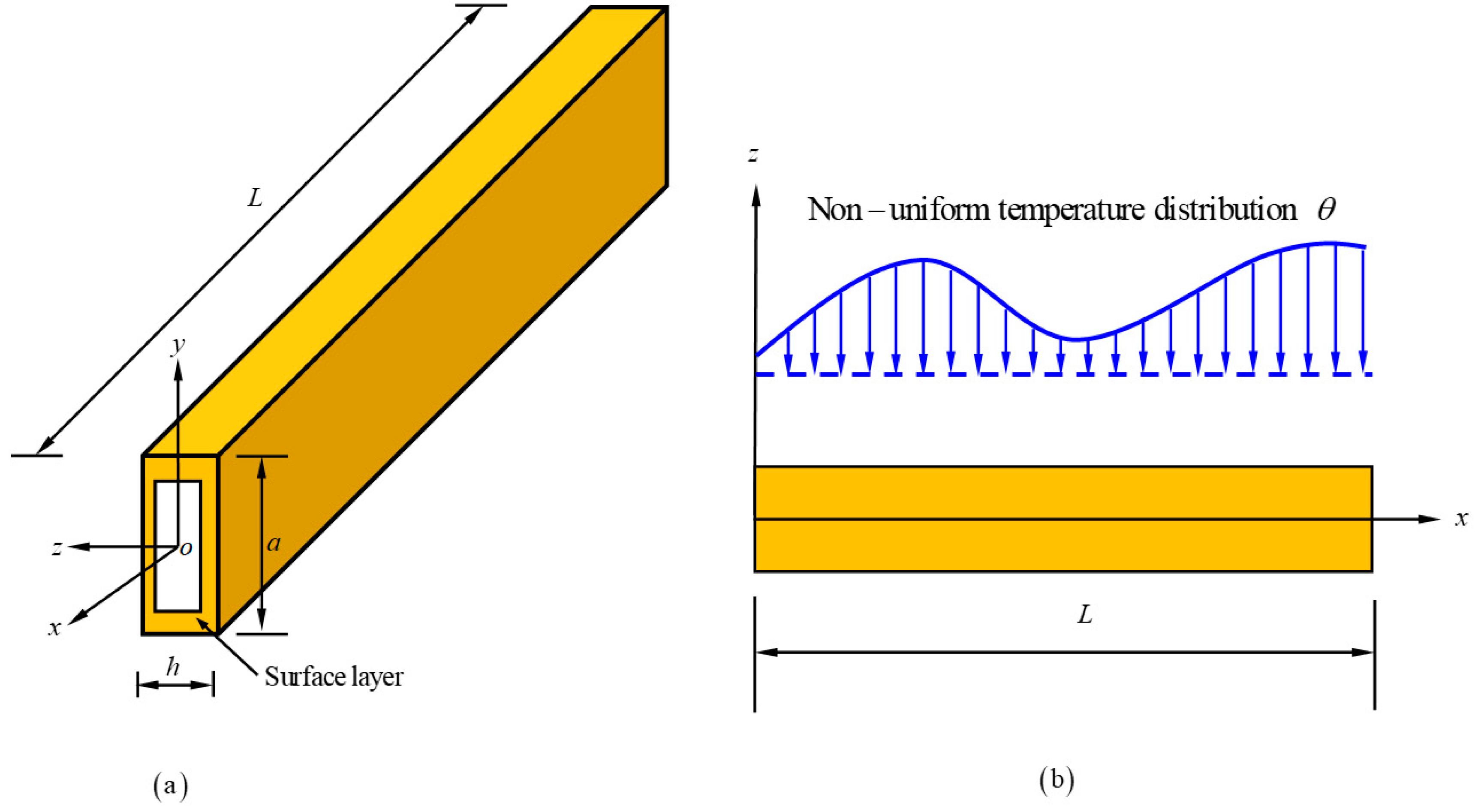

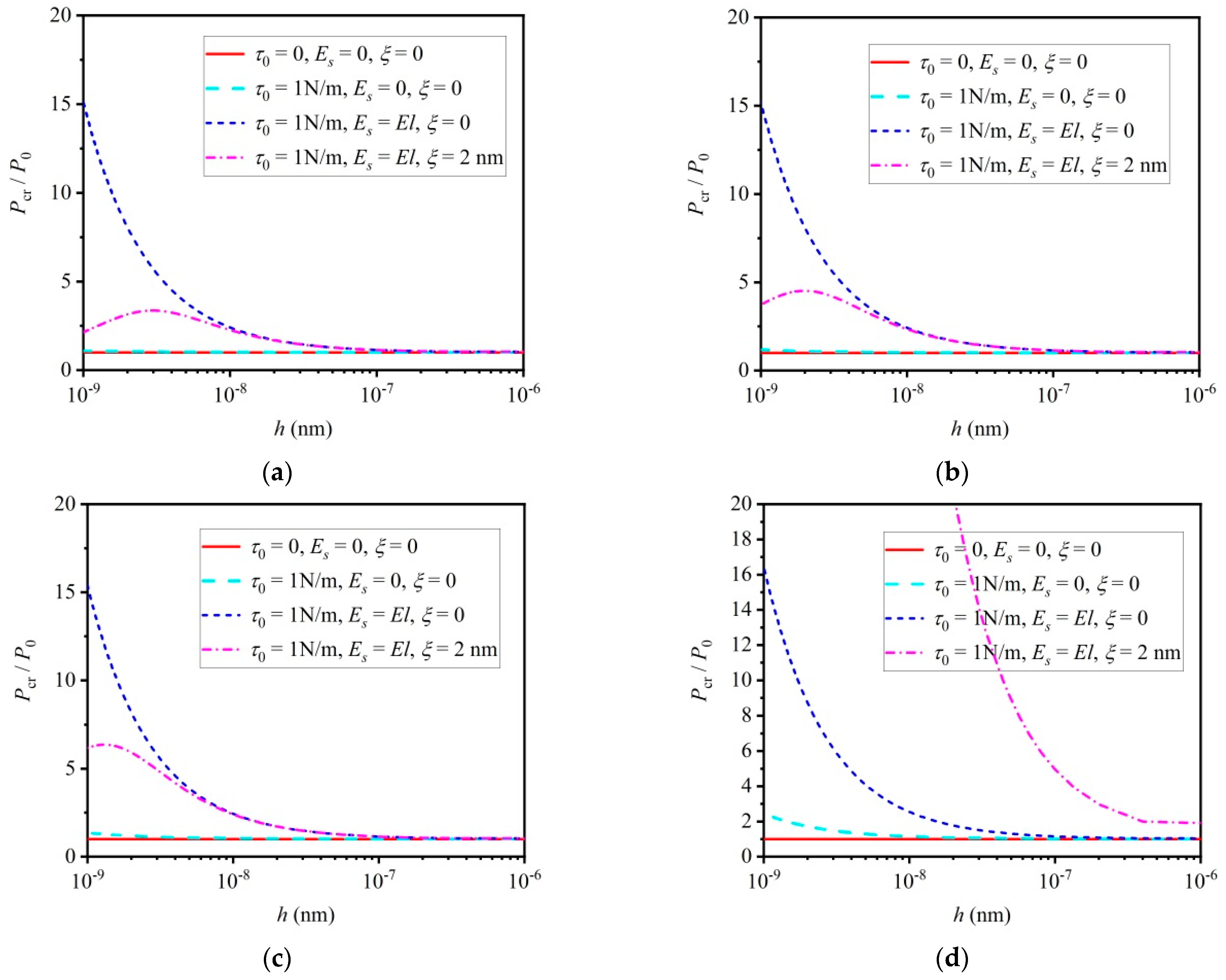

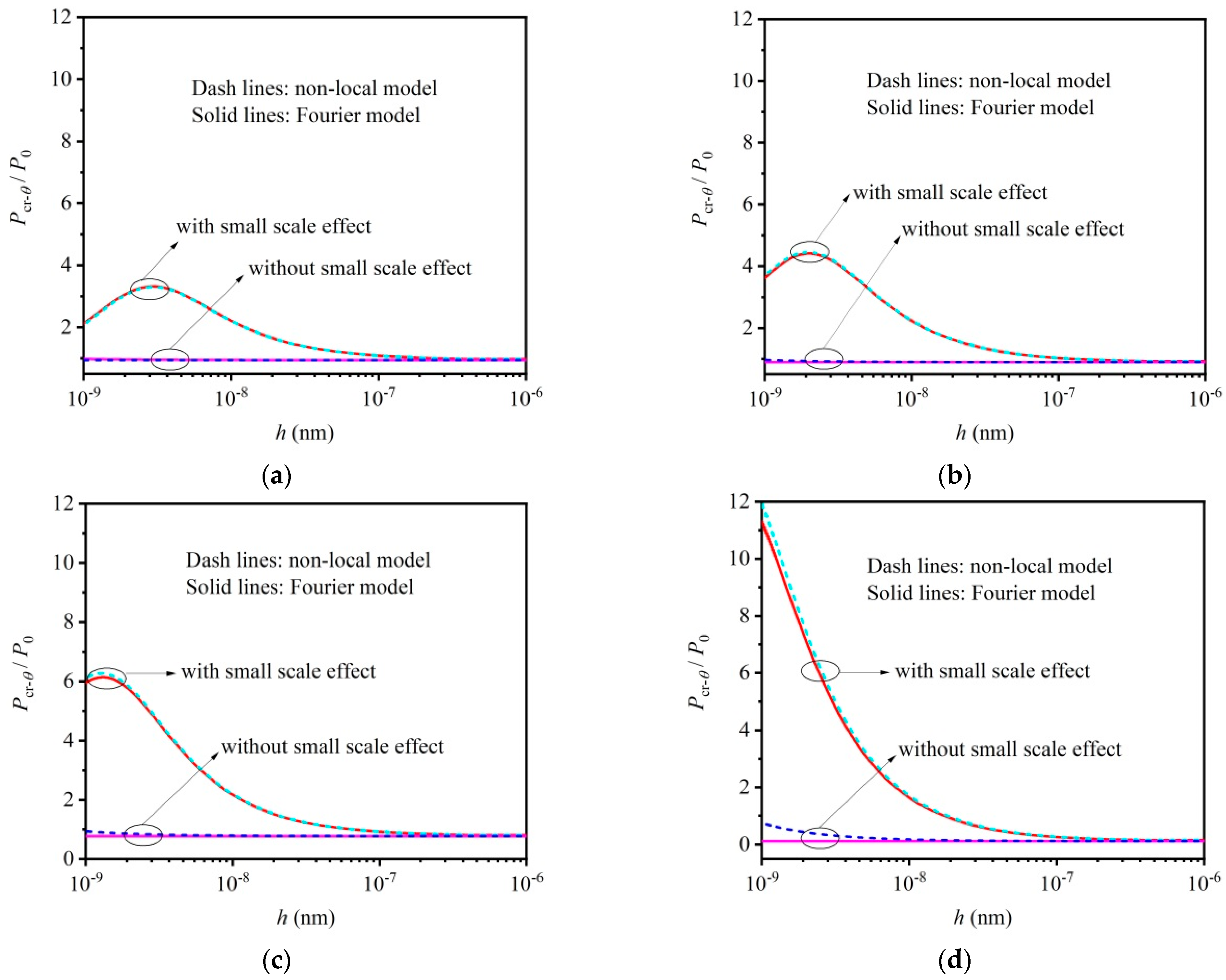
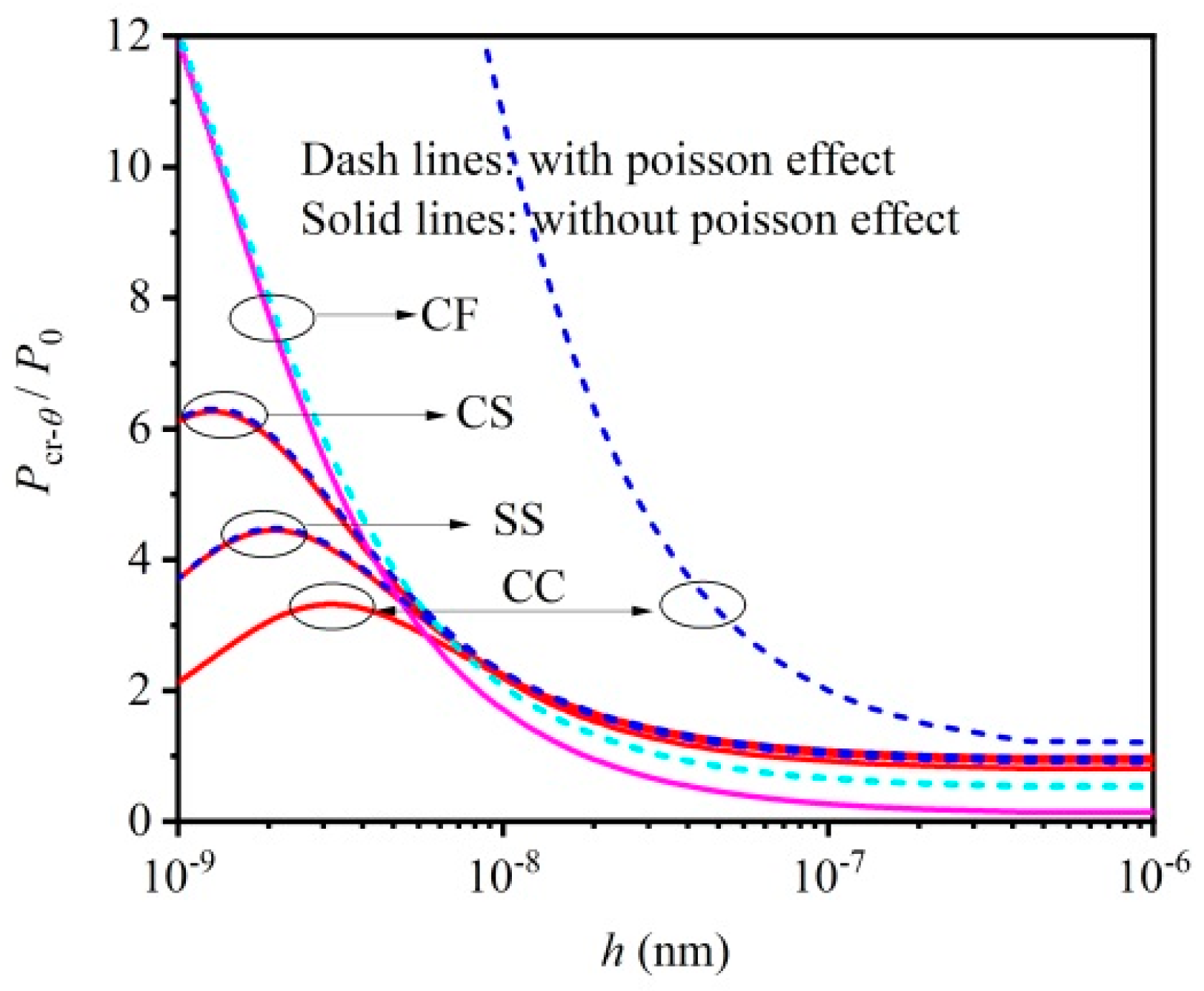
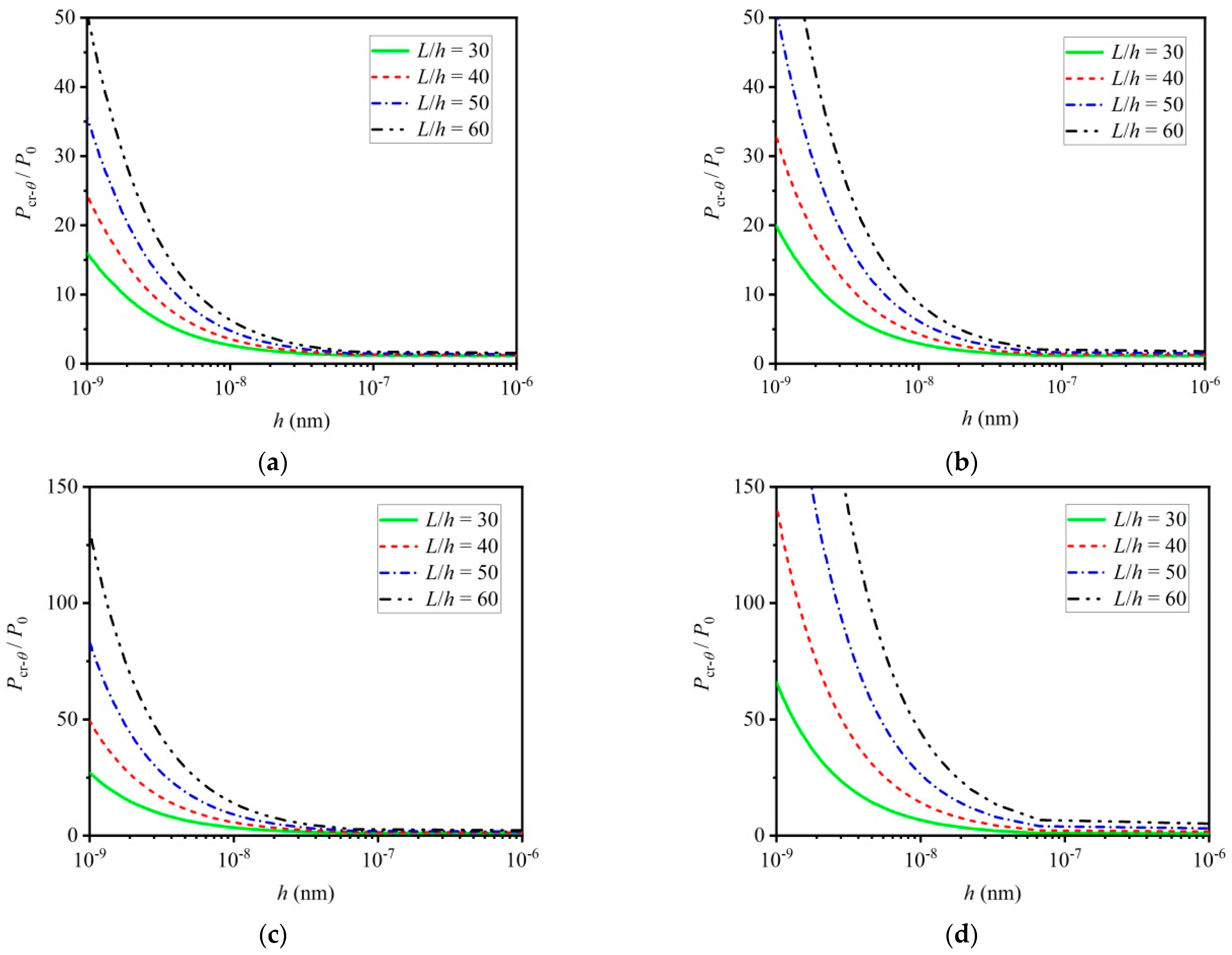
Disclaimer/Publisher’s Note: The statements, opinions and data contained in all publications are solely those of the individual author(s) and contributor(s) and not of MDPI and/or the editor(s). MDPI and/or the editor(s) disclaim responsibility for any injury to people or property resulting from any ideas, methods, instructions or products referred to in the content. |
© 2023 by the authors. Licensee MDPI, Basel, Switzerland. This article is an open access article distributed under the terms and conditions of the Creative Commons Attribution (CC BY) license (https://creativecommons.org/licenses/by/4.0/).
Share and Cite
Ren, X.; Shi, S. A Buckling Analysis of Thermoelastic Micro/Nano-Beams Considering the Size-Dependent Effect and Non-Uniform Temperature Distribution. Materials 2023, 16, 6390. https://doi.org/10.3390/ma16196390
Ren X, Shi S. A Buckling Analysis of Thermoelastic Micro/Nano-Beams Considering the Size-Dependent Effect and Non-Uniform Temperature Distribution. Materials. 2023; 16(19):6390. https://doi.org/10.3390/ma16196390
Chicago/Turabian StyleRen, Xin, and Shuanhu Shi. 2023. "A Buckling Analysis of Thermoelastic Micro/Nano-Beams Considering the Size-Dependent Effect and Non-Uniform Temperature Distribution" Materials 16, no. 19: 6390. https://doi.org/10.3390/ma16196390
APA StyleRen, X., & Shi, S. (2023). A Buckling Analysis of Thermoelastic Micro/Nano-Beams Considering the Size-Dependent Effect and Non-Uniform Temperature Distribution. Materials, 16(19), 6390. https://doi.org/10.3390/ma16196390






